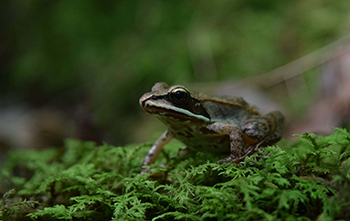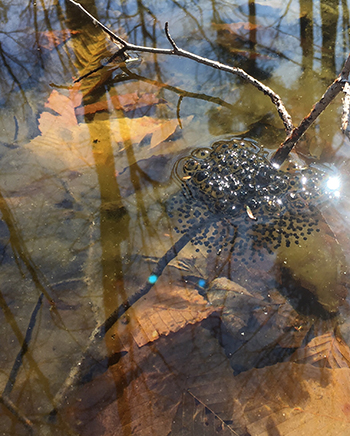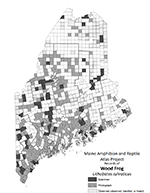Home → Fish & Wildlife → Wildlife → Species Information → Reptiles & Amphibians → Wood Frog
Wood Frog
Lithobates sylvaticus
On this page:

Photo: Derek Yorks
Distinguishing Characteristics
- Small to medium-sized, approximately 1.5 to 2.5 inches in length
- Brownish, pale tan, or dark reddish brown, with white underside
- Distinct black “mask” behind eyes
- White upper lip
- Prominent ridges (dorsolateral folds) along sides of back from behind eye to near groin
- Breeding call sounds like a duck quack
Status and Distribution in Maine
- Common and secure
- Statewide
Habitat
- Entirely terrestrial except during breeding season
- Prefers moist, forested upland areas
- Breed in temporary or semi-permanent water, such as vernal pools
Diet
- Tadpoles eat algae and various aquatic microorganisms, and adults eat a variety of invertebrates including spiders, beetles, moth larvae, and slugs
Seasonal Changes
- Hibernate in rotting logs and stumps or under moss or leaf litter on the forest floor
Natural History Notes

Photo: Phillip deMaynadier
- One of a few Maine frogs that can withstand freezing temperatures in forest leaf litter. Can freeze solid for days at a time during winter by producing glucose, a natural antifreeze, in its tissues
- Explosive breeder, entire population may breed within three days
Share Your Sighting
There is much still to learn about the distribution and ecology of Maine’s herpetofauna, and we encourage members of the public to share their photo-documented observations as part of the Maine Amphibian & Reptile Atlas Project (MARAP).
To see if a township still needs documentation of a species, consult this distribution map (PDF). If a township lacks a photo or specimen record, we want your observation!
There are two ways to share your observations:
Submit your reptile or amphibian observation online
No service? No problem. Click here to download the survey to your device while connected, then take offline to collect observations from anywhere. Tip: The survey works best on Google Chrome and Safari.
Or upload sightings to the iNaturalist citizen science project through their website at iNaturalist.org or mobile app.
- When submitting an observation through iNaturalist add a description of the location (and other noteworthy information) to the “notes” field. This serves as a check on the locations automatically generated by smartphone cameras, which may be imprecise if cell service or GPS coverage is weak.
Thank you for doing your part to help conserve Maine’s reptiles and amphibians.
